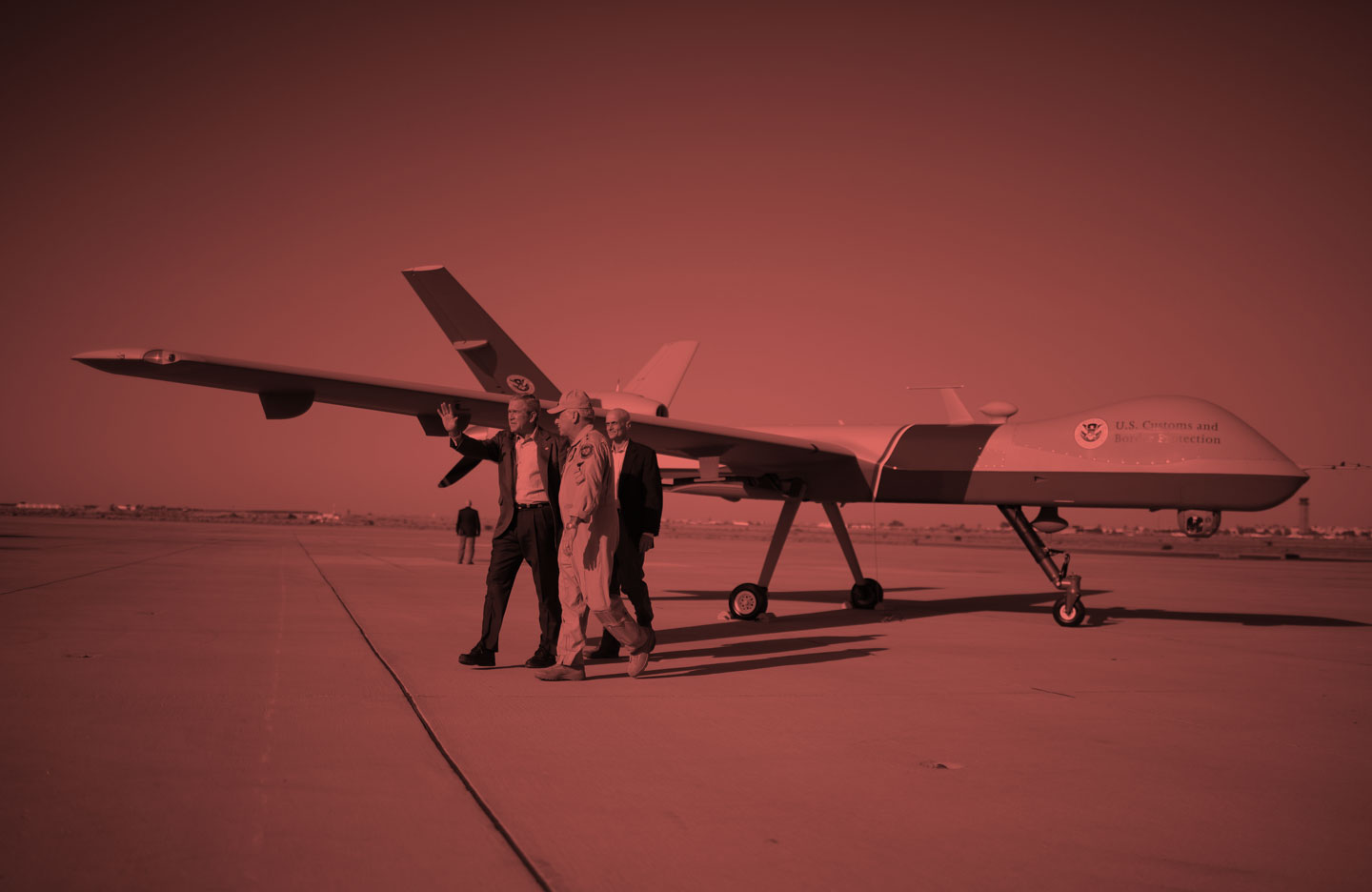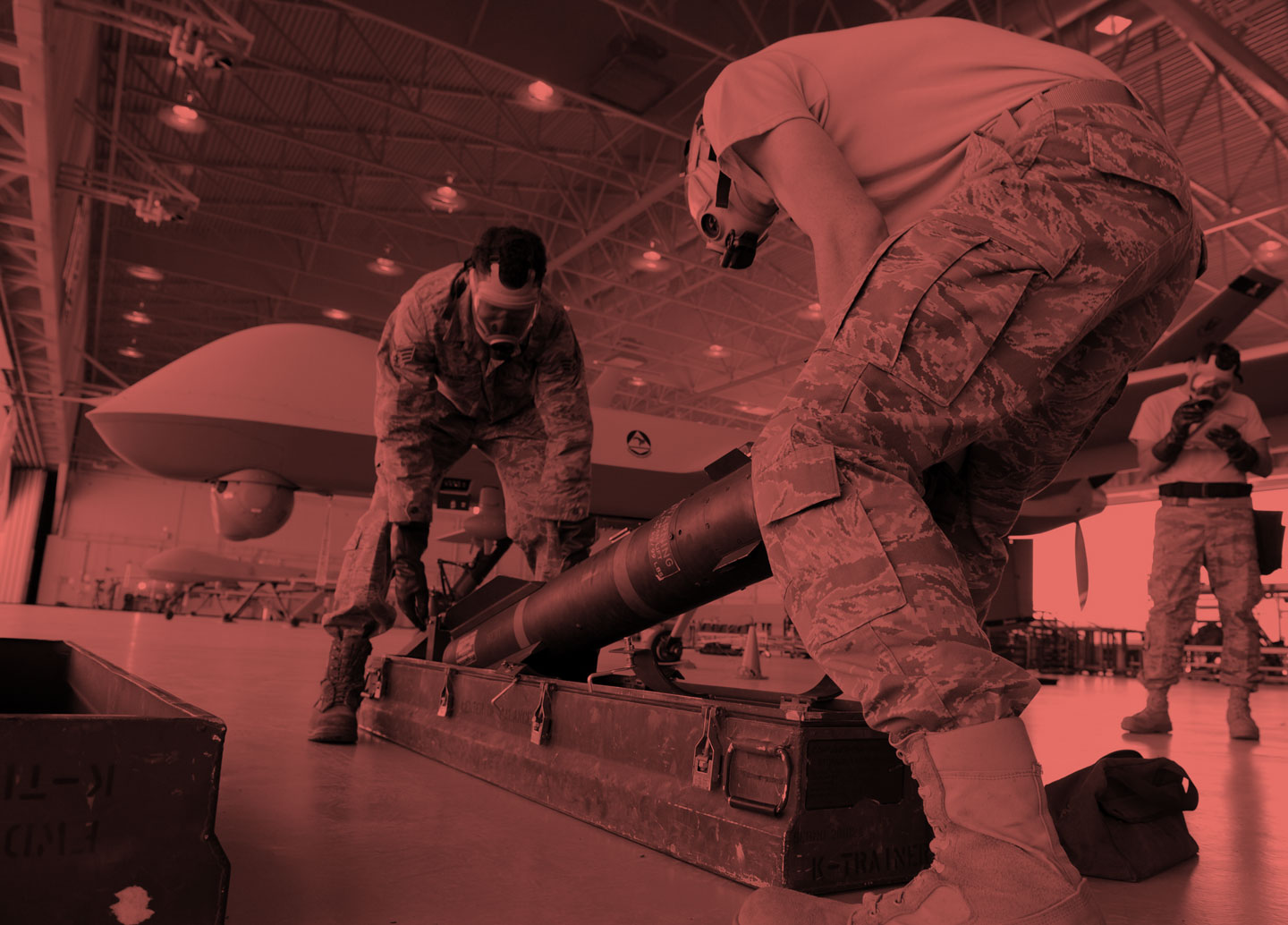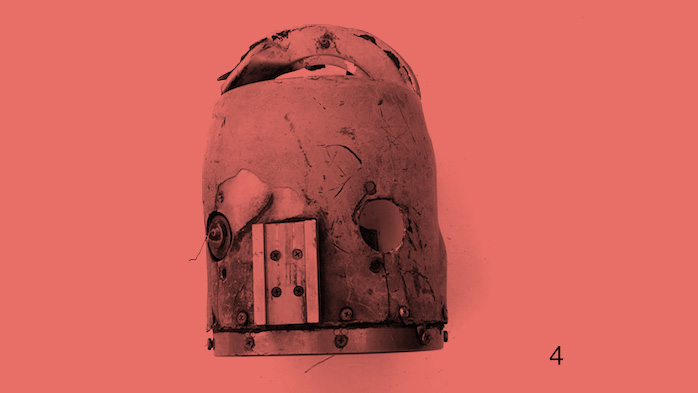President George W. Bush inspects a Reaper drone used to patrol the Arizona-Mexico border in 2007. Credit: Charles Ommanney, The Bureau Investigates.
…
“I am sorry to say that with the importation of what will be tens of thousands of drones, by both U.S. military and by commercial interests, into U.S. airspace, with a specific mandate to engage in surveillance and with the capacity for weaponization—which is due to begin in earnest at the start of the new year—it means that the police state is now officially here.”
—Naomi Wolf writing for The Guardian in 2013
The Reaper drone, illustrated above, is a direct descendant of the Predator—the drone that initiated the modern age of remotely piloted warfare.
…Part 1
Hunter-Killers
Hunter-Killers
How does the military refer to drones?
Drones have possessed several names: remotely piloted vehicles, unmanned aircraft, unmanned aerial vehicles. Only recently have they been called “drones.” The military uses “unmanned aircraft systems” (uas) in recognition of the components required to fly an aircraft without an onboard pilot. uas aircraft can be flown remotely or pre-programmed to fly autonomously and re-programmed from the ground while airborne.
Are military drones flown autonomously?
The Predator and Reaper can be programmed for autonomous flight or flown remotely by pilots on U.S. bases thousands of miles away.
How many Predator and Reaper drones are operated by the Air Force?
Air Force drones controlled by the cia
Targets the cia is able to continuously stalk
20
“The weapons’ names suggest ruthless and inhumane characteristics. The first drone aircraft deployed by the cia and Air Force after 2001 was the Predator,[a name] suggestive that the enemy was not human but merely prey, that military operations were not combat subject to the laws of war but a hunt.
The Predator’s manufacturer, General Atomics, later developed the larger Reaper, a moniker implying that the United States was fate itself, cutting down enemies who were destined to die.”
—John Sifton writing for The Nation
Hunter-Killers
How does the bigger, faster, deadlier Reaper drone compare to the Predator?
The Predator drone was conceived as a reconnaissance drone. Within six years of its initial deployment in the Bosnian War, the Air Force weaponized the Predator to launch Hellfire missiles. Its faster, deadlier sibling—the Reaper drone—was deemed a “hunter-killer” to distinguish it as intentionally designed to seek-and-strike targets.

Airmen prepare to load an AGM–114 missile onto a Reaper drone. Credit: Staff Sgt. Alice Moore, The U.S. Air Force.
…“My uavs were not meant to be armed.”
—Abraham Karem, inventor of the Predator drone
Hunter-Killers
How deadly is the Reaper?
For over a decade, drones have served as the primary weapon in a covert war across the Middle East, Pakistan, and Somalia. The Obama administration has referred to these drone strikes as “surgical” and capable of targeting individuals with “laser-like focus.” The reality is less precise. Blast radii vary from as little as a few feet to up to twenty meters in diameter. 100-pound Hellfire missiles can obliterate anyone within up to 60 feet of the intended target.
Vertical casualty radii of a Reaper’s weapon payload.
Casualty radii of a Reaper’s weapon payload across Fenway Park.
“These missiles are very powerful. They destroy human beings. There is nobody left and small pieces left behind. Pieces. Whatever is left is just little pieces of bodies and cloth.”
—Firoz Ali Khan, a shopkeeper whose father-in-law’s home was struck by Hellfire missiles in Islamabad, Pakistan
Part 2
Homeland

A Reaper drone designed for domestic surveillance is unveiled and delivered to the U.S. Customs and Border Protection agency. Source: General Atomics
…“The U.S. Customs and Border Protection’s drone program is shrouded in secrecy and legal ambiguity.”
—Amie Stepanvich, Associate Litigation Counsel for Electronic Privacy Information Center
homeland
Whom has the U.S. Customs and Border Protection (cpb) flown missions for?
For the past decade, the cpb has routinely flown drones in the U.S., however little is known about the agency’s drone program. In 2011, the Electronic Frontier Foundation filed suit against the cpb for more information. The cpb released three years of flight logs revealing that they continuously lent their fleet of Predator and Reaper drones to an increasing number of agencies for hundreds of missions unrelated to border security.
2010
2011
2012
How many missions did the cpb fly for other agencies?
687
Which agencies did the cpb fly the most missions for?
How many drones are flown by the cpb?
Total fleet
10
By model
What is the range of the cpb’s surveillance program?
Part 3
Roost
How will our skies appear when law enforcement agencies, corporations, and citizens begin flying drones next year?
…Next Year
How long until the faa opens our nation’s airspace to drones?
days
hours
minutes
seconds
Next Decade
How many drones are estimated to fly our nation’s airspace by 2020?
30,000
How many manned aircraft are expected to fly in the U.S. by 2020?
7,608
What will the estimated ratio of drones to manned aircraft be in 2020?
4:1
op/ed
Drones are coming home to roost.
June 16, 2014. ¶ In February of 2012 Congress told the Federal Aviation Administration (faa) to open the national airspace to drone traffic by September of 2015. In 2013 the faa released the “Civil UAS Roadmap:” a plan to pave the skyways by clearing the regulations that have thus far kept government and private domestic drones at bay (for the most part) and creating a new regulatory infrastructure to welcome drones home.
Privacy means more than not being watched for illegal activity. Privacy—the secret ballot—is the foundation of democracy. Surveillance undermines the secret ballot because when the government knows what you read, who you associate with, and what you talk about, it knows how you vote. And now, if the government doesn’t like how you vote—or what you read, write, or talk about for that matter—they can send the military to follow you around and monitor everything you do with a flying robot.
They’ll have the rights to spy on you anywhere.
Consider the Fourth Amendment out the window. With the approval from the Secretary of Defense, the Air Force will have the right to fly surveillance drones to collect information on targeted civilians without warrant. The Air Force may keep the data on record up to 90 days before it determines whether to retain the material.
Customs and Border Protection is already contemplating weaponizing its drones. Though not yet approved, drones outfitted with rubber bullets are a real possibility. By 2015, protests could be controlled by armed police and federal drones.
It doesn’t matter if you have nothing to hide. This is really, really not good for democracy. This is the military policing us; that’s called martial law.
By 2020, the faa estimates that 30,000 drones owned by the military, police departments, local governments, and corporations will occupy American skies. Consider that drones can film you in detail from two miles up, intercept your texts out of thin air, slurp up data from your computer through your Wi-Fi network, and detect human breathing. The nsa will no longer need to get its data from your service provider. 30,000 drones will mean blanket surveillance.
